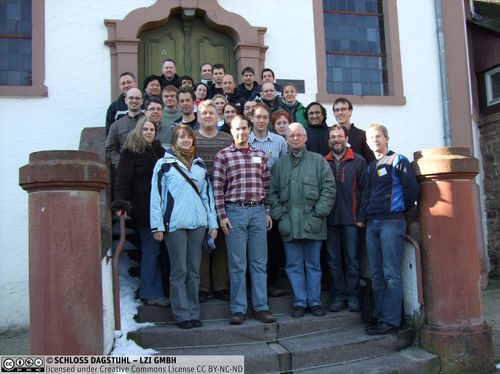Dagstuhl Seminar 09081
Similarity-based learning on structures
( Feb 15 – Feb 20, 2009 )
Permalink
Organizers
- Michael Biehl (University of Groningen, NL)
- Barbara Hammer (TU Clausthal, DE)
- Sepp Hochreiter (Universität Linz, AT)
- Stefan C. Kremer (University of Guelph, CA)
- Thomas Villmann (Hochschule Mittweida, DE)
Contact
Schedule
The seminar centered around different aspects of similarity-based clustering with the special focus on structures. This included theoretical foundations, new algorithms, innovative applications, and future challenges for the field.
Similarity-based learning methods have a great potential as an intuitive and flexible toolbox for mining, visualization, and inspection of large data sets across several disciplines. While state-of-the-art methods offer efficient solutions for a variety of problems such as the inspection of huge data sets occuring in genomic profiling, satellite remote sensing, medical image processing, etc.\ a number of important questions requires further research.
The detection, adequate representation, and comparison of structures turned out to be one key issue in virtually all applications. Frequently, learning data contain structural information such as spatial or temporal dependencies, higher order correlations, relational dependencies, or complex causalities. Thus, learning algorithms have to cope with these data structures. In this context, various qualitatively different aspects can be identified: often, data are represented in a specific structured format such as relational databases, XML documents, symbolic sequences, and the like. Similarity based learning has to identify appropriate preprocessing or similarity measures which facilitate further processing. Several problem formulations are ill-posed in the absence of additional structural information e.g.\ due to a limited availability of labeled examples for high dimensional data. The dimensionality of microarray data, mass spectra, or hyperspectral images, for example, usually exceeds the number of labelled examples by magnitudes. Structural information can offer effective means for regularization and complexity reduction. More and more learning tasks require additional structural information instead of simple vectorial outputs such as multiple output values, hierarchies, dependencies, or relational information, as required for the inference of biological networks or the analysis of social graphs, for example.
The aim of the seminar was to bring together researchers who develop, investigate, or apply machine learning methods for structure processing to further advance this important field. The focus has been on advanced methods which have a solid theoretical background and display robust and efficient performance in large-scale interdisciplinary applications.
All in all, the presentations and discussion (often until late at night) revealed that similarity based learning on structures constitutes a highly evolving field. Significant progress has been achived in recent years and was highlighted during the seminar. Although promising results and approaches were developed, many important problems still await satisfactory practical solutions. For example, the functional aspect of data is not sufficiently exploited in many data processing methods. Another challenge is the sparseness of data in high-dimensional data analysis and adequate processing tools.
- Gyan Bhanot (Rutgers University - Piscataway, US) [dblp]
- Michael Biehl (University of Groningen, NL) [dblp]
- Ulrich Bodenhofer (Universität Linz, AT) [dblp]
- Joachim M. Buhmann (ETH Zürich, CH) [dblp]
- Kerstin Bunte (University of Groningen, NL) [dblp]
- Hans Burkhardt (Universität Freiburg, DE)
- Djork-Arné Clevert (Universität Linz, AT)
- Gert-Jan de Vries (Philips Research Lab. - Eindhoven, NL) [dblp]
- Martijn Dijkstra (University Medical Center Groningen, NL)
- Paolo Frasconi (University of Florence, IT) [dblp]
- Tina Geweniger (Universität Leipzig, DE) [dblp]
- Hinrich Göhlmann (Janssen Pharmaceutica - Beerse, BE) [dblp]
- Alexander Hasenfuss (TU Clausthal, DE)
- Sepp Hochreiter (Universität Linz, AT) [dblp]
- Jens Keilwagen (IPK Gatersleben, DE)
- Stefan C. Kremer (University of Guelph, CA)
- Erzsébet Merényi (Rice University - Houston, US) [dblp]
- Gianluca Pollastri (University College Dublin, IE) [dblp]
- Fabrice Rossi (Télécom ParisTech, FR) [dblp]
- Juho Rousu (University of Helsinki, FI) [dblp]
- Craig Saunders (University of Southampton, GB)
- Frank-Michael Schleif (Universität Leipzig, DE) [dblp]
- Petra Schneider (University of Groningen, NL) [dblp]
- Stefan Simmuteit (Universität Leipzig, DE)
- Marc Strickert (IPK Gatersleben, DE) [dblp]
- Alexandra Teynor (Universität Freiburg, DE)
- Peter Tino (University of Birmingham, GB) [dblp]
- Michel Verleysen (University of Louvain, BE) [dblp]
- Nathalie Villa-Vialaneix (University III of Toulouse, FR) [dblp]
- Thomas Villmann (Hochschule Mittweida, DE) [dblp]
- Aree Witoelar (University of Groningen, NL)
- Dietlind Zühlke (Fraunhofer Institut FIT - St. Augustin, DE) [dblp]
Related Seminars
- Dagstuhl Seminar 07131: Similarity-based Clustering and its Application to Medicine and Biology (2007-03-25 - 2007-03-30) (Details)
Classification
- artificial intelligence
- robotics
- soft computing
- evol. algorithms Interdisciplinary with non-informatics-topic: bioinformatics
Keywords
- similarity-based clustering and classification
- metric adaptation and kernel design
- learning on graphs
- spatiotemporal data


